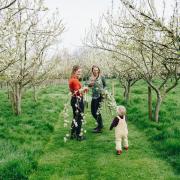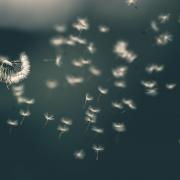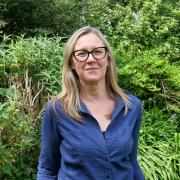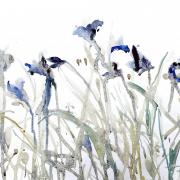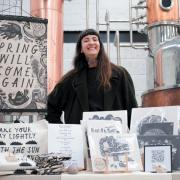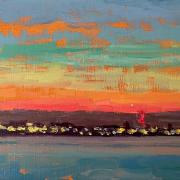Art is a passion and a business for Emma Dunbar, whose colourful and vibrant work is in demand from private clients and galleries. As Sandra Smith discovers, this is an artist who really delivers the goods
From crockery to table napkins, scales and a submarine, the items Emma Dunbar is asked to include in her commissions are as individual to the buyer as they are surprising to the artist. Not that such requests faze her.
“Commissions are twice as difficult because you’re trying to please yourself and the client,” Emma declares from her Kingsley Common home. “You need to know what they want in the back of your mind and there is an onus to give them that, to conform to expectations. At the end of the day people are looking for a product. You have to keep a straight face; there’s no point being on a high horse about it.”
Such an easy going attitude fits with the colourful naivety of this artist’s work. Her bright compositions are bursting with life, innocence, curiosity. Misleadingly simple at first glance, each painting provokes familiarity and a smile, a feel good factor in acrylics.
When I ask about early artistic influences, however, Emma’s response is all but obvious: “I grew up in a house where you couldn’t even find Sellotape,” she laughs, “I was the ‘What are we going to do with her?’ child. I had a Great Aunt Edith who painted oils in her lean-to; she seemed like 100 years old even if she wasn’t. At school I was allowed to stay in at break to paint the school scenery for plays. I used to make things like birthday cards and clothes and sell them in shops or markets. I always knew I wanted to go to Art College.”
With no direction in mind, a foundation year proved to be a “wonderful” experience and was followed by a degree in Fine Art Printmaking which appealed to a desire to have a technique, a practical involvement alongside painting. Afterwards, the government’s Enterprise Allowance Scheme provided financial support to set up her own business. “I trolled around galleries with my prints from college and painted from home. You carry on little by little and get a few lucky breaks. Friends would tell people about my work and I’d go and see them, knock on doors.”
Working in galleries gave Emma an appreciation of that side of the business so she knew what information to provide when trying to sell her art. She learned the importance of consistency and pricing whilst her entrepreneurial attitude fuelled an impetus to succeed. Decades later, her degree course continues to influence her art. “I work in layers like a print maker. I paint flowers because of their colour; I put them in front of other things, bringing in flat shapes and sometimes things going on in the background. It’s a bit like stage sets and instead of perspective, each layer is in its own plane.”
In an upstairs room at home (plans for a purpose built studio were shelved when the children moved out) Emma is creating a painting inspired by a bunch of Sweet Williams, a gift from a friend. Although naturally vibrant, the tones are enhanced in order to give them extra “zing”. It is this boldness and bravery in colour which surely encompasses the artist’s signature style.
I wonder whether she has a bank of ideas or needs to lookout for inspiration. Turns out she does both. With ongoing concepts surfacing during daily dog walks Emma also recalls when she spotted alpacas in a field of buttercups backed by a row of cottages.
“I move along in galloping circles,” the 56-year-old muses. “I come back to things then I move in though I don’t come back in the same way. I have painted allotments for 15 years and revisited the idea at least four times. You can see continuity but also how they’ve moved on. The most recent are almost abstract because they are looking at what is in the allotments. The ones overlooking the sea are more integral to a place rather than a jumble of marks and abstract textures.”
Painting often begins with little square thumbnails, quickly putting down colour while scenes are memory fresh. She then paints onto marine ply whose texture and solid surface she prefers to the springiness of canvas. Although brushes are favoured, anything which scratches through paint – including knitting needles – are used. Intriguingly, the dimensions of her images vary considerably though the appeal of larger work is dampened by practicalities. “I like to paint big pieces but it isn’t what people want. Bigger paintings make a much bigger statement. And require extra big brushes. I would love to paint large paintings and have somewhere for them to go.”
Emma is practical in her approach, recognising that art is her job which, like any other profession, demands regular commitment. She favours natural daylight and admits that, if she takes days off, a similar amount of time is needed to get back to where she was. Although successful relationships with galleries have been built she smiles when recalling another outlet she didn’t initially take seriously. “When my husband set up my website I thought, if anyone buys from there I’ll eat my hat. Well, I’ve eaten several since then! People are more savvy now, they look on the back of greetings cards, Google your name. But if people don’t know your work they still want to see it in the flesh.”
Emma recognises that her paintings have improved over time, while layering and composition remain similar and early images enjoy continuing popularity. Timescales differ these days and there is a degree of pressure from galleries, but she always agrees to their requests for paintings. Expectations, from gallery owners and the public, means conforming to expectations. Self assured, professionally shrewd, level headed, Emma encapsulates elements which anyone running a business needs yet which many artists struggle to embrace. On the other hand, modest recognition of her working life borders on gratitude. “My ambition is to be able to carry on. I make a living and justify spending every day painting. I’m one of the lucky ones. Some people have to commute to London although I’m not very disciplined and there are distractions at home. Back in the day I wouldn’t be flicking through an iPad.”
Emma’s images are in galleries around the country, she is a regular exhibitor at art fairs and holds her own Open Studio in November. It’s a typical gesture by a talented artist with an eye for marketing. Go along and I promise her acrylic compositions will not only raise a smile, you might also be tempted to buy.
More…
• Writer Matthew ‘M.J.’ Arlidge on why Hampshire is a perfect fit for Detective Inspector Helen Grace - The detective writer who chose Southampton as the setting for his dark novels tells Faith Eckersall why the city - and the New Forest beyond - are a perfect fit with his ‘fractured’ heroine, Detective Inspector Helen Grace






